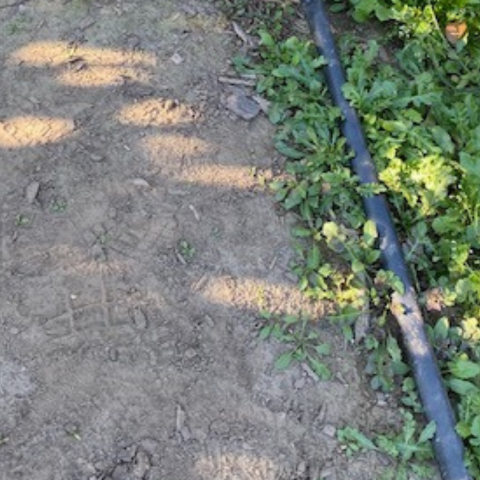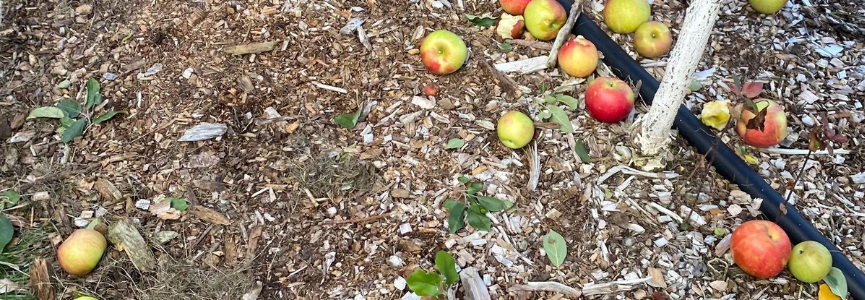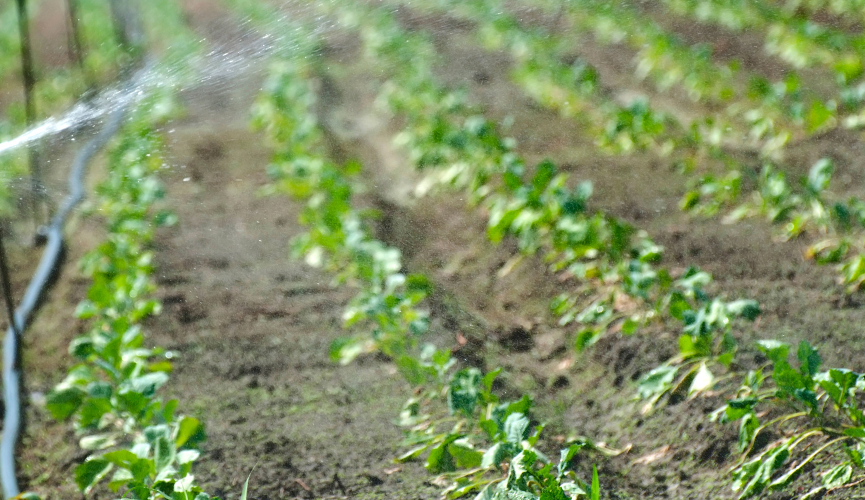Sweet New Earth is an ad free and entirely reader-supported site.
When you purchase products through links on our site, we may earn a commission which supports our reviews.
Learn more.
Can You Bury Drip Irrigation Lines?

Key Takeaways
- Yes, you can your drip irrigation lines
- Burying drip irrigation requires careful planning and installation
- Anything over 6" deep should be buried in PVC tubing
Drip irrigation systems are a popular choice for gardeners and farmers alike, as they offer a more efficient and precise way to water plants.
However, one question we often get is 'can you bury drip irrigation lines?' To keep it short, yes you can bury your drip irrigation lines.

Burying Your Drip Irrigation Lines
So you want to bury your drip irrigation lines. Well, there's a few things you should know.
You'll need to plan out the layout of your system, taking into account the specific needs of your plants and the terrain of your garden or farm.
You'll also need to choose the right type of tubing or pipe, as well as any necessary connectors and fittings.
Finally, you'll need to install the system carefully to ensure that the lines are buried at the appropriate depth and that they are properly connected to your water source.

How Deep Should You Bury Your Drip Irrigation Lines? Two Options
When burying your drip lines, there are a few different techniques you can use.
One option is to dig a trench and bury the tubing at a depth of 6-12 inches, depending on the soil type and water requirements of your plants.
Another option is to bury the drip irrigation lines just below the surface, which involves laying the tubing on the soil surface and covering it with a layer of mulch or soil.
This method can be particularly effective for raised beds, as it allows for easy access to the tubing for maintenance and repairs.
Overall, burying drip irrigation lines can be a great option for those who want a clean and unobtrusive look in their garden or raised beds.
By taking the time to plan and install your system properly, you can ensure that your plants receive the water they need to thrive.
Benefits of Burying Your Drip Tubing
Drip irrigation is a water-efficient method of irrigation that delivers water directly to the roots of plants. Not only does it save water, but it also reduces runoff and soil erosion.
Water Conservation & Reducing Runoff: Burying drip irrigation lines can help conserve water by reducing evaporation and minimizing runoff. When drip irrigation lines are buried, the water is delivered directly to the roots of plants, reducing the amount of water lost to evaporation.
Additionally, burying drip irrigation lines can reduce runoff by ensuring that the water is absorbed by the soil rather than running off the surface.
Preventing Soil Erosion: Soil erosion can be a significant problem in yards and gardens, particularly on slopes. Burying drip irrigation lines can help prevent soil erosion by delivering water directly to the roots of plants and minimizing the amount of water that runs off the surface. Subsurface irrigation also helps maintain soil moisture levels, reducing the likelihood of soil erosion.
Maintenance & Repair
As with any irrigation system, drip lines require regular maintenance to ensure they function properly and efficiently.
Routine Inspection & Maintenance: Regular inspections are crucial to maintaining the health and longevity of your drip irrigation system. We recommend inspecting your system at least once a month, especially during the growing season.
During these inspections, check for any damaged or broken drip mitters, as well as any leaks or blockages in the lines. It is also important to check your filters regularly and clean or replace them as needed. Clogged filters can reduce water flow and cause damage to your system over time.
Identifying & Repairing Leaks: It will be considerably harder to identify and repair leaks for a buried drip irrigation system. This is something you need to take into account before you start digging up complex trenches.
Leaks and blockages can significantly reduce the efficiency of your drip irrigation system. To identify leaks, look for wet spots or puddles around your plants or along the lines. Blockages can be identified by reduced water flow or no water flow at all.
If you notice either of these issues, start by inspecting the affected line for any damage or holes. If there are no visible issues, try flushing the line with water to remove any debris or blockages. If the issue persists, you may need to replace the affected line or emitter.
Rodents & Roots: Burying your lines doesn't always protect them from rodents. Rodents will dig deep in search of water. Roots as well - haven't you ever seen roots grow into plumbing?
Rodents and plant roots can also cause damage to your drip irrigation system. To protect against rodent intrusion, use mesh or wire barriers around your lines and emitters. You can also use rodent repellent sprays or baits to deter them from your garden.
Plant roots can also grow into your lines and cause blockages or damage. To prevent this, consider using root barriers or placing your lines in raised garden beds. Regularly inspecting your lines for any signs of root intrusion can also help prevent damage.
Winterizing Your Drip Irrigation System
If you live in a cold area, you need to remember that you'll have to winterize your drip irrigation system. Not doing so risks damaging the entire system.
Even if you bury your drip irrigation lines, you still need to winterize the lines.
To winterize buried drip irrigation systems, first turn off the water supply to the system and drain any remaining water from the lines. Then, remove the emitters and flush the lines with clean water to remove any debris or sediment.
If needed, you can use an air compressor to blow water out of the lines. Avoid using too much pressure in the lines.
Final Say On Burying Drip Irrigation Line
Yes, you can bury your drip irrigation line. Most people don't want to dig up a trench for an underground network of drip irrigation tubes.
Most people will be fine with lay a thin layer of soil or mulch over the drip irrigation tubing. Anything over 3 to 6", an you need to carefully plan out how you are going to bury your lines.
Can You Bury Drip Irrigation Tubing FAQs
-
How deep should drip irrigation lines be buried?
If you want to cover your drip irrigation tubes, you can do so with a thin layer of soil or mulch. But if you want to bury your drip irrigation lines, then you should do no more than 12". Anything over 6" is deep enough to protect the lines from foot traffic, lawn mowers, and other equipment. Additionally, burying the lines at this depth helps to prevent water evaporation and keeps the soil moist.
-
Is it possible to cover drip irrigation lines with mulch or rocks?
Yes, it is possible to cover drip irrigation lines with mulch or rocks. However, it is important to ensure that the mulch or rocks do not cover the emitters or the tubing. You also want to make sure you do not collapse the drip irrigation tubing with heavy rocks or excessive mulch.
-
Can drip irrigation be buried with PVC piping?
Yes, drip irrigation can be buried with PVC piping. PVC piping can be used to connect the main water supply to the drip irrigation system and to create a manifold for distributing water to different zones. It is important to use the appropriate fittings and connectors to ensure a secure and leak-free connection.
-
Are there any benefits or drawbacks to burying drip tape?
Burying drip tape can provide several benefits, such as protecting the lines from damage and reducing water evaporation.
However, burying the lines can also make it more difficult to access and maintain the system.
Additionally, burying the lines too deep can cause clogging and other issues. It is important to carefully consider the pros and cons before deciding to bury drip tape.
-
How To Choose The Right Size Drip Tubing
The size of drip irrigation tubing should be chosen based on the flow rate and pressure of the water supply, as well as the length of the tubing and the number of emitters. It is important to select tubing with a large enough diameter to ensure adequate water flow and pressure to all parts of the system.

Carl Anderson
Carl Anderson is an avid outdoorsman with a keen interest in writing about and reviewing tools. He has over 20 years of writing experience and the only time he isn't feverishly typing away at his computer is when he's outside in nature working on his projects. You can learn more about him here.
Join our community!
Join to receive guides, insights, and the latest gardening deals!
Newsletter
Thank you for subscribing!
Please try again later
Sweet New Earth is reader-supported. When you buy through links on our site, we may earn an affiliate commission.
All Rights Reserved | Sweet New Earth
